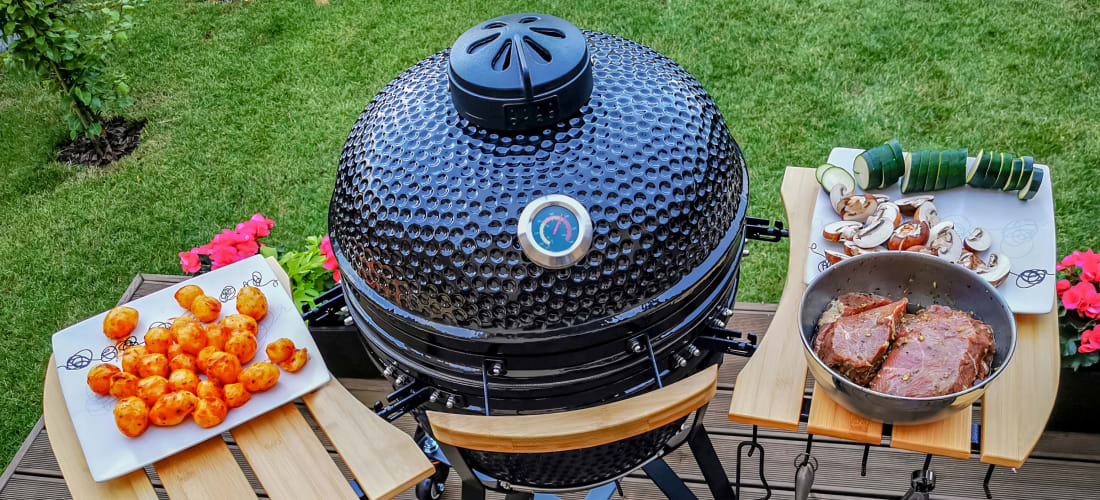
Grilling Evolution: Transitioning from Kettle to Kamado
Published: April 10, 2024As the smoke billows and the aroma of sizzling meat fills the air, grilling aficionados often find themselves contemplating upgrades to their trusty kettle grill. For many, the allure of longer cooks and increased efficiency beckons, prompting a shift towards the versatile kamado-style grill. In this article, we'll explore the journey of making the switch, from understanding the differences between kettle and kamado grills to weighing the advantages and considering the right choice for your grilling needs.
Understanding the Differences: Kettle vs. Kamado
The kettle grill, with its iconic round shape and straightforward design, has long been a staple of backyard barbecues. In contrast, the kamado grill, inspired by ancient Japanese cooking traditions, boasts a ceramic construction that offers superior heat retention and precise temperature control. While the kettle grill excels in simplicity and affordability, the kamado grill sets itself apart with its versatility and ability to achieve long, slow cooks with minimal fuel consumption.
Cooking Techniques: Kettle vs. Kamado Style
From direct grilling and indirect grilling to smoking and baking, both kettle and kamado grills offer a range of cooking techniques to suit different culinary preferences. While the kettle grill is well-suited for quick heat-up times and straightforward grilling, the kamado grill shines in its ability to maintain consistent temperatures for extended periods, making it ideal for low-and-slow cooking and achieving tender, flavorful results.
Assessing Clear Benefits
When considering the benefits of one grill over the other, it's essential to weigh factors such as portability, simplicity, versatility, and temperature control. While the kettle grill may appeal to those seeking affordability and ease of operation, the kamado grill offers unmatched heat retention, precise temperature control, and the versatility to grill, smoke, roast, and bake with exceptional results.
Advantages of Kettle Grills over Kamado Grills
For some grillers, the simplicity and affordability of kettle grills remain unmatched. With their straightforward design and quick heat-up times, kettle grills are well-suited for spontaneous backyard gatherings and casual weeknight dinners.
Advantages of Kamado Grills over Kettle Grills
However, the kamado grill boasts several advantages that may sway the decision for those seeking enhanced capabilities and versatility in their grilling endeavors. With its ceramic construction, the kamado grill excels in heat retention, allowing for precise temperature control and the ability to maintain consistent heat over long cooks. Additionally, the kamado grill's versatility extends to smoking, roasting, and even baking, offering a wide range of culinary possibilities for adventurous grillers.
Evaluating Cost Considerations
While the initial investment in a kamado grill may be higher than that of a kettle grill, it's essential to consider factors such as durability, longevity, and potential cost savings over time. With its superior heat retention and fuel efficiency, the kamado grill may prove to be a worthwhile long-term investment for serious grillers looking to elevate their outdoor cooking experience.
Making the Right Choice
Ultimately, the decision to switch from a kettle to a kamado grill hinges on personal preferences, cooking goals, and budget considerations. Whether you opt for the simplicity of a kettle grill or the versatility of a kamado grill, both offer unique advantages and the opportunity to explore new flavors, techniques, and culinary experiences in your backyard oasis.
Conclusion
As you embark on your grilling evolution, from kettle to kamado, may your culinary adventures be filled with sizzling steaks, tender ribs, and mouthwatering barbecue delights. Whether you choose the time-honored simplicity of the kettle grill or the innovative versatility of the kamado grill, embrace the journey of exploration and discovery as you elevate your outdoor cooking game to new heights.
Grill Guru Insights: Your Top Kamado vs. Kettle FAQs Answered
Dive into our comprehensive FAQ section to uncover expert answers to the most pressing questions about transitioning from a kettle to a kamado grill. From understanding the key differences to weighing the advantages and considerations, we've got you covered with essential insights to inform your grilling journey.
Kamado grills are typically made of ceramic with superior heat retention and precise temperature control, while kettle grills are made of metal and offer simplicity and affordability.
While both grills can produce excellent results, kamado grills offer superior heat retention and versatility for various cooking methods, including grilling, smoking, roasting, and even baking.
While kamado grills may require a learning curve for temperature control, their precise heat management and versatility make them suitable for both novice and experienced grillers.
Kettle grills are often more affordable, easier to transport, and quicker to heat up, making them ideal for casual backyard grilling and spontaneous gatherings.
Kamado grills excel in heat retention, precise temperature control, versatility in cooking methods, and the ability to achieve long, slow cooks with minimal fuel consumption.
While the initial investment in a kamado grill may be higher, its superior features, longevity, and versatility may justify the cost for grillers seeking enhanced capabilities and long-term durability.
Yes, kamado grills can accommodate a wide range of grilling techniques, including direct grilling, indirect grilling, smoking, roasting, and even baking, allowing for endless culinary creativity.
While kamado grills may offer optional accessories for expanded functionality, they generally require minimal maintenance beyond regular cleaning and occasional replacement of gaskets or seals.
Transitioning from a kettle to a kamado grill may require adjusting to the new cooking style and temperature control methods, but with practice, most grillers find it manageable and rewarding.
Consider factors such as cooking preferences, budget, space availability, and long-term grilling goals to determine which grill type best suits your needs and lifestyle.
